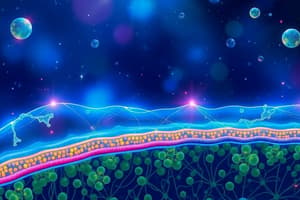Podcast
Questions and Answers
What is the main requirement for active transport?
What is the main requirement for active transport?
- High concentration gradient
- Cellular energy (correct)
- Large cell membrane surface area
- Passive diffusion
Which type of active transport uses adenosine triphosphate (ATP)?
Which type of active transport uses adenosine triphosphate (ATP)?
- Primary active transport (correct)
- Secondary active transport
- Osmosis
- Facilitated diffusion
What does secondary active transport use to achieve movement?
What does secondary active transport use to achieve movement?
- Facilitated diffusion
- Passive transport proteins
- Osmotic pressure
- Electrochemical gradient (correct)
What is the main characteristic of passive transport?
What is the main characteristic of passive transport?
Which physiological process is dependent on active transport?
Which physiological process is dependent on active transport?
In humans, other mammals, and birds, how many chambers is the heart divided into?
In humans, other mammals, and birds, how many chambers is the heart divided into?
What is the protective sac enclosing the heart called?
What is the protective sac enclosing the heart called?
What is the main function of the heart in the circulatory system?
What is the main function of the heart in the circulatory system?
What prevents backflow of blood in a healthy heart?
What prevents backflow of blood in a healthy heart?
Where is the heart located in humans?
Where is the heart located in humans?
Flashcards are hidden until you start studying
Study Notes
Active Transport
- Requires energy to move molecules across a cell membrane, against their concentration gradient.
- Primary active transport utilizes ATP directly to move molecules against their concentration gradient.
- Secondary active transport uses the energy stored in the concentration gradient of one molecule to move another molecule against its concentration gradient.
Passive Transport
- Does not require energy to move molecules across a cell membrane.
- Molecules move down their concentration gradient, from an area of high concentration to an area of low concentration.
Heart
- Four chambers in humans, other mammals, and birds.
- Enclosed by a protective sac called the pericardium.
- Main function is to pump blood throughout the circulatory system.
- Valves prevent backflow of blood.
- Located in the chest cavity, slightly to the left of the center.
Other Processes
- Active transport plays a crucial role in maintaining cell function, including nutrient uptake and waste removal.
Studying That Suits You
Use AI to generate personalized quizzes and flashcards to suit your learning preferences.



